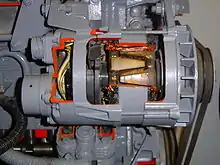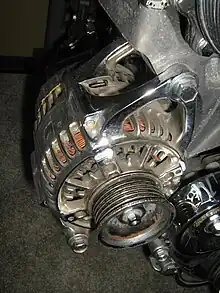
An alternator is a type of electric generator used in modern automobiles to charge the battery and to power the electrical system when its engine is running.
Until the 1960s, automobiles used DC dynamo generators with commutators. As silicon-diode rectifiers became widely available and affordable, the alternator gradually replaced the dynamo. This was encouraged by the increasing electrical power required for cars in this period, with increasing loads from larger headlamps, electric wipers, heated rear windows, and other accessories.
Design


Most passenger vehicles and light trucks use alternators with Lundahl or 'claw-pole' field construction. This uses a shaped iron core on the rotor to produce a multi-pole field from a single coil winding. The poles of the rotor look like fingers of two hands interlocked with each other. The coil is mounted axially inside this and field current is supplied by slip rings and carbon brushes. These alternators have their field and stator windings cooled by axial airflow, produced by an external fan attached to the drive belt pulley.[1]
Modern alternators typically use a 'compact' layout which results in better cooling. In this design, the casing has distinctive radial vent slots at each end and now encloses the fan. Two fans are used, one at each end, and the airflow is semi-radial, entering axially and leaving radially outwards.[2] The stator windings now consist of a dense central band where the iron core and copper windings are tightly packed, and end bands where the windings are more exposed for better heat transfer. The closer core spacing from the rotor improves magnetic efficiency. The smaller, enclosed fans produce less noise, particularly at higher machine speeds.[2] However, a small proportion of cars use a water-cooled alternator instead of an air-cooled design.
Larger vehicles sometimes use a salient pole alternator, as used in large machinery.[3] Brushless versions of these type alternators are also common in larger machinery, such as highway trucks and earthmoving machinery.
The windings of a 3-phase alternator may be connected using either the delta or star (wye) connection regime set-up.[4]
Efficiency of automotive alternators is limited by fan cooling loss, bearing loss, iron loss, copper loss, and the voltage drop in the diode bridges. Efficiency reduces dramatically at high speeds mainly due to fan resistance. At medium speeds efficiency of today's alternators is 70–80%.[5]
History
The modern type of vehicle alternators were first used in military applications during World War II, to power radio equipment on specialist Fitted For Wireless vehicles. After the war, other vehicles with high electrical demands — such as ambulances and radio taxis — could also be fitted with optional alternators.[6]
Alternators were first introduced as standard equipment on a production car by the Chrysler Corporation on the Valiant in 1960, several years ahead of Ford and General Motors.[6][7]
Magnetos in early automobiles
Some early automobiles, like the Ford Model T, used a different sort of charging system: an engine-driven magneto which generated low-voltage alternating current that was supplied to trembler coils, which provided the high voltage needed to generate ignition sparks. (This was different from a true ignition magneto, which generates high voltage directly.) Since such a magneto system only depended on the engine's motion to generate current, it could even be used when starting a manually cranked engine, provided the crank was pulled sharply, so that the magneto would produce enough current for the coils to make good sparks.
The Model T incorporated its magneto into the engine flywheel. The first Model Ts used the magneto solely for the trembler coil ignition. Beginning with the 1915 model year, Ford added electric headlights, also powered by the magneto.[8][9] The magneto circuit was strictly AC, with no battery included. (There was a switch on the ignition coils to use a battery instead, which could be helpful when starting in cold weather, but Ford neither provided a battery nor did it encourage the use of one before it introduced an electric starter in 1919. The owner would have to install the battery themselves and charge it externally.)
Starting in the 1919 model year, Ford upgraded the Model T to include an electric starter, which was standard for some models and optional for others. This starter installation also included a battery, charged by a conventional dynamo, and the lights were now powered by the battery. However, the flywheel magneto still powered the ignition, and since models without the starter had no battery, they continued to use magneto-powered lights.[10][11]
See also
References
- ↑ "Electrical System and Power Supply". Automotive Handbook (3rd ed.). Bosch. 1993. pp. 770–1. ISBN 0-8376-0330-7.
- 1 2 Bosch & 3rd, p. 771
- ↑ Bosch & 3rd, pp. 771–772
- ↑ "Understanding 3 phase alternators..." windstuffnow.com. Retrieved 2012-07-24.
- ↑ Horst Bauer (ed.) Automotive Handbook 8th Edition, Robert Bosch GmbH, Stuttgart, 2011, ISBN 978-0-8376-1686-5, page 993
- 1 2 "Alternators and Generators". Allpar.
- ↑ "Valiant by Chrysler" (PDF). Valiant promotional brochure. Chrysler Corporation (Australia). 1962.
Another Chrysler "first" ... the amazing new alternator
- ↑ "Encyclopedia: 1915". Model T Ford Club of America.
- ↑ "Encyclopedia: 1915 and 1916 [comprehensive description]". Model T Ford Club of America.
- ↑ "Encyclopedia: 1919". Model T Ford Club of America.
- ↑ "Encyclopedia: 1917 to 1920 [comprehensive description]". Model T Ford Club of America.